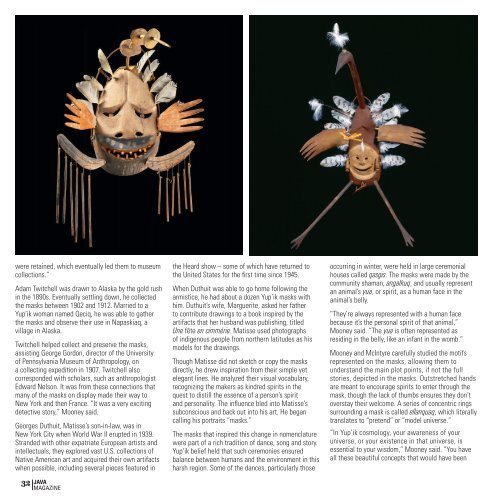JAVA Dec '18 issue
Create successful ePaper yourself
Turn your PDF publications into a flip-book with our unique Google optimized e-Paper software.
were retained, which eventually led them to museum<br />
collections.”<br />
Adam Twitchell was drawn to Alaska by the gold rush<br />
in the 1890s. Eventually settling down, he collected<br />
the masks between 1902 and 1912. Married to a<br />
Yup’ik woman named Qeciq, he was able to gather<br />
the masks and observe their use in Napaskiaq, a<br />
village in Alaska.<br />
Twitchell helped collect and preserve the masks,<br />
assisting George Gordon, director of the University<br />
of Pennsylvania Museum of Anthropology, on<br />
a collecting expedition in 1907. Twitchell also<br />
corresponded with scholars, such as anthropologist<br />
Edward Nelson. It was from these connections that<br />
many of the masks on display made their way to<br />
New York and then France. “It was a very exciting<br />
detective story,” Mooney said.<br />
Georges Duthuit, Matisse’s son-in-law, was in<br />
New York City when World War II erupted in 1939.<br />
Stranded with other expatriate European artists and<br />
intellectuals, they explored vast U.S. collections of<br />
Native American art and acquired their own artifacts<br />
when possible, including several pieces featured in<br />
32 <strong>JAVA</strong><br />
MAGAZINE<br />
the Heard show – some of which have returned to<br />
the United States for the first time since 1945.<br />
When Duthuit was able to go home following the<br />
armistice, he had about a dozen Yup’ik masks with<br />
him. Duthuit’s wife, Marguerite, asked her father<br />
to contribute drawings to a book inspired by the<br />
artifacts that her husband was publishing, titled<br />
Une fête en cimmérie. Matisse used photographs<br />
of indigenous people from northern latitudes as his<br />
models for the drawings.<br />
Though Matisse did not sketch or copy the masks<br />
directly, he drew inspiration from their simple yet<br />
elegant lines. He analyzed their visual vocabulary,<br />
recognizing the makers as kindred spirits in the<br />
quest to distill the essence of a person’s spirit<br />
and personality. The influence bled into Matisse’s<br />
subconscious and back out into his art. He began<br />
calling his portraits “masks.”<br />
The masks that inspired this change in nomenclature<br />
were part of a rich tradition of dance, song and story.<br />
Yup’ik belief held that such ceremonies ensured<br />
balance between humans and the environment in this<br />
harsh region. Some of the dances, particularly those<br />
occurring in winter, were held in large ceremonial<br />
houses called qasgis. The masks were made by the<br />
community shaman, angalkuq, and usually represent<br />
an animal’s yua, or spirit, as a human face in the<br />
animal’s belly.<br />
“They’re always represented with a human face<br />
because it’s the personal spirit of that animal,”<br />
Mooney said. “The yua is often represented as<br />
residing in the belly, like an infant in the womb.”<br />
Mooney and McIntyre carefully studied the motifs<br />
represented on the masks, allowing them to<br />
understand the main plot points, if not the full<br />
stories, depicted in the masks. Outstretched hands<br />
are meant to encourage spirits to enter through the<br />
mask, though the lack of thumbs ensures they don’t<br />
overstay their welcome. A series of concentric rings<br />
surrounding a mask is called ellanquaq, which literally<br />
translates to “pretend” or “model universe.”<br />
“In Yup’ik cosmology, your awareness of your<br />
universe, or your existence in that universe, is<br />
essential to your wisdom,” Mooney said. “You have<br />
all these beautiful concepts that would have been

















